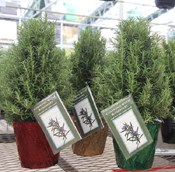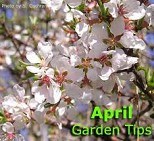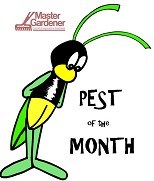Rosemary plants are popping up in nurseries at the holidays among the mini-Christmas tree alternatives. Image credit: Sharon Dowdy.
Rosemary plants are gaining popularity as a holiday gift and miniature, living Christmas tree. After the holidays, you can use it as an indoor houseplant. With a little care, holiday rosemary plants can be added to the landscape in the spring.
Botanically speaking, Rosmarinus officinalis is an aromatic, woody shrub that originated in the Mediterranean. The word “rosemary” is derived from the Latin rosmarinus, meaning, “dew of the sea.” This refers to where it grows natively, among the misty hills of the Mediterranean coast, in France, Italy, Spain and the Dalmatian Islands.
Rosemary is an herb steeped in history, and valued for many reasons. It was used in wine, perfumes and medicines. It was also used as an air purifier and aromatic kitchen herb. And it may help repel mosquitoes when planted near patios or porches.
During the holiday season, rosemary plants are often sheared into formal topiaries or Christmas tree shapes. Most of the rosemary plants sold during the holiday season were grown in greenhouses. Therefore, they don’t react kindly to being transported, displayed and then carried through the cold into the dry warmth of heated homes.
Every light touch of the needle-like leaves releases enough fragrance to perfume an entire room. Even if the plants don’t survive indoors past the holiday season, they make wonderful temporary houseplants.
It’s mostly the dry heat in our homes that make survival difficult for rosemary plants. Raising the humidity level can help the plant survive. Also keep the plant away from direct sunlight, heat registers, fireplaces, televisions and other heat sources.
Routinely spray the leaves several times a day with water from a hand mister. Place the plant’s container on a tray of stones or marbles so that as the water evaporates, it helps humidify the plant. Clustering houseplants together also helps keep foliage hydrated.
In late winter, if your rosemary plant is still living, start placing it outside in a sheltered spot during the day. Protect it from drying winds, and you may be rewarded by new growth. After it has acclimated itself to the outdoors, you can safely plant it outside where the rosemary plant will thrive year round.
Rosemary does best in slightly alkaline, well-drained soil and can handle either full sun or light shade. It can grow to be 3 to 5 feet in height, and because of its Mediterranean origins, rosemary is naturally drought resistant once it becomes established.
With a little extra care, the gift of a rosemary plant can survive and become a remembrance of the holiday season and add seasoning to your favorite recipes.
SOURCE: Louise Estabrook, University of Georgia Cooperative Extension agricultural and natural resources agent in Cherokee County. November 21, 2013.





